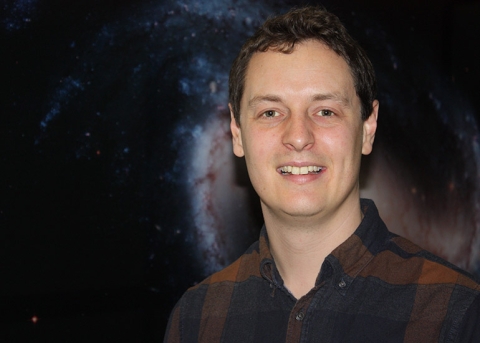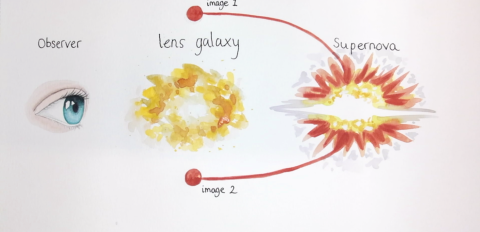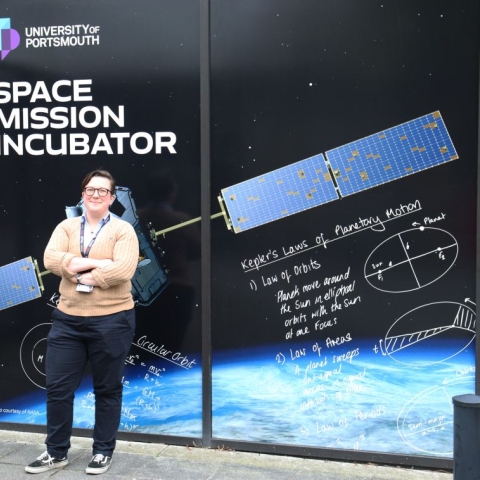

Dr Thomas Collett, from the University's Institute of Cosmology and Gravitation, was in the research team
13 June 2023
6 min read
An international team of physicists and astronomers, including University of Portsmouth researchers, has made an intriguing breakthrough in our ability to explore how galaxies warp the surrounding space with the discovery of a multiply-imaged lensed Type Ia supernova, dubbed “SN Zwicky”.
The results are published in Nature Astronomy.
The team, led by Ariel Goobar from the Oskar Klein Centre at Stockholm University, discovered an unusual Type Ia supernova, SN Zwicky. Type Ia supernovae play a crucial role in measuring cosmic distances. They were used for the discovery of the accelerated expansion of the universe, leading to the 2011 Nobel prize in physics.
The newly discovered supernova stands out due to its extraordinary brightness and configuration of multiple images, a rare phenomenon predicted by Albert Einstein's theory of general relativity.

Under extraordinary circumstances, large astronomical bodies act as cosmic magnifying glasses. These magnifying glasses also create multiple light paths visible at different positions in the sky. Illustration: Nikki Arendse
Dr Thomas Collett, from the University of Portsmouth’s Institute of Cosmology and Gravitation, said: “When a white dwarf star grows beyond a critical mass it explodes as a supernova. These bright beacons are visible across the cosmos, shining as bright as entire galaxies. We have discovered an extremely rare gravitationally lensed supernova, called Zwicky. This supernova is split into four images by the immense gravitational field of a galaxy that is perfectly aligned between us and the Zwicky.
“Thanks to studies of supernovae we know that the expansion of the Universe is getting faster, but we don't understand why this is happening. Lensed supernovae will help solve this mystery as they provide a new measurement of the expansion history of the Universe. With new telescopes coming online, we expect to find dozens of these systems in the next five years: it's a very exciting time to work in this new field.”
Within weeks of detecting the supernova at the Zwicky Transient Facility at Palomar Observatory, the team observed SN Zwicky with the adaptive optics instruments on the W. M. Keck Observatory atop Maunakea, Hawaiʻi, and the Very Large Telescopes in Chile. The Keck Observatory observations resolved the multiple images, confirming the strong lensing hypothesis behind the unusual supernova brightness. The four images of SN Zwicky were also observed with NASA’s Hubble Space Telescope.
With new telescopes coming online, we expect to find dozens of these systems in the next five years: it's a very exciting time to work in this new field.
Dr Thomas Collett, Principal Research Fellow
The multiply-imaged lensing effect observed in SN Zwicky is the result of the gravitational field exerted by a foreground galaxy acting as a gravitational lens. Under extraordinary circumstances, large astronomical bodies act as cosmic magnifying glasses. These magnifying glasses also create multiple light paths visible at different positions in the sky.
Observing the multiple images not only reveals details about the strongly lensed supernova, it also offers a unique opportunity to explore the properties of the foreground galaxy that causes the deflection of light. This could teach astronomers more about the inner cores of galaxies and dark matter. Lensed supernovae are also very promising tools to refine models describing the expansion of the universe.
As scientists continue to unravel the complexities of the universe, the discovery of SN Zwicky's multiply-imaged lensing presents new avenues for investigating gravitational lensing phenomena and their implications for cosmology. This is an important step towards unlocking the mysteries of dark matter, dark energy, and the ultimate fate of our cosmos.
Joel Johansson, a postdoctoral fellow at Stockholm University and a co-author on the study, said: “The extreme magnification of SN Zwicky gives us an unprecedented chance to study the properties of distant Type Ia supernova explosions, which we need when we use them to explore the nature of dark energy.”
Professor Ariel Goobar, the project's principal investigator and the director of the Oskar Klein Centre at Stockholm University, expressed his enthusiasm for this significant finding: "The discovery of SN Zwicky not only showcases the remarkable capabilities of modern astronomical instruments but also represents a significant step forward in our quest to understand the fundamental forces shaping our universe."
The team's findings have been published in Nature Astronomy, in a paper titled "Uncovering a population of gravitational lens galaxies with magnified standard candle SN Zwicky". The publication provides a comprehensive analysis of SN Zwicky, including imaging and spectroscopic data collected from telescopes around the world.
You might also like...
Portsmouth academics ranked among the world's top physicists
8 June 2023
4 minutes

NASA-inspired space mission design facility awarded £100k
A unique new mission design service, inspired by NASA JPL, has won £100k funding from the UK Space Agency for its set-up phase at the University of Portsmouth.
7 June 2023
5 min read

Portsmouth cosmologists join UK Space Agency 'Space for Everyone' tour
1 June 2023
4 minutes

